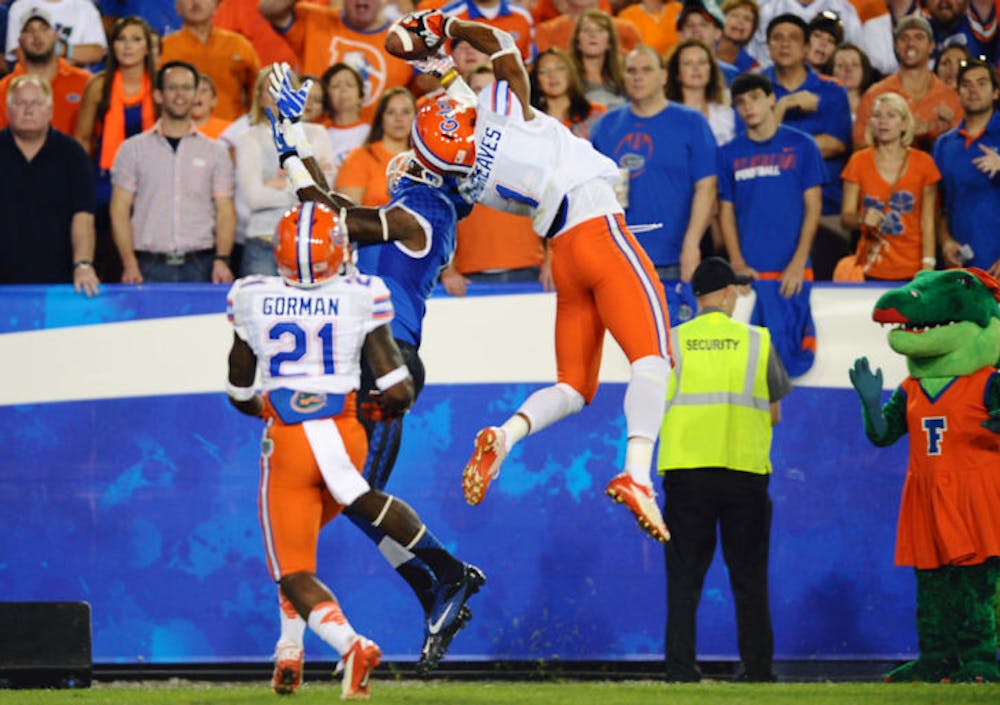Did you hear that Thursday night? That’s the collective relieved exhale of an entire fanbase.
If you were at a local watering hole, one would imagine another round was ordered immediately after the tweets were read about Vernon Hargreaves III’s left knee.
An entire corner of the college football universe sat on its hands to await the news of an MRI, and the elephant in the room was “is this really happening again?”
The scars of 2013 for this fanbase have not healed completely, even though the ACLs of its players have. The posttraumatic stress of a 4-8 year with a veritable mash unit on the sidelines every week still looms large, and it was clear to see when Hargreaves went down.
He put ice on the knee, and then took his pads off then left the field in a cart visibly frustrated.
Then the waiting game began until coach Will Muschamp said in a statement that Hargreaves had sustained only a bone bruise.
Muschamp said Friday that his star cornerback went knee to knee with a wide receiver earlier in practice.
After that, Hargreaves’ injury was re-aggravated during a skirmish that occurred between some wide receivers and the defensive backs.
“Obviously in any situation when you deal with a joint, whether it's an ankle, a shoulder, a knee, an elbow, you're going to always get an MRI,” Muschamp said. “But our trainer told me last night it was a bone bruise and he'll be day to day.”
A bone bruise is commonly considered as the step before a fracture, where the fibrous tissue in the medullary part of the bone is injured as opposed to being broken — which occurs during a fracture.
There are three common types of bone bruises: First a sub-periosteal hematoma, where the thin covering of a bone is injured thanks to blunt force and then blood gathers underneath.
Next is an inter-osseous bruise, which occurs after repeated force is inflicted on the bone. This type of bone bruise commonly affects the marrow on the inside of the bone.
The final type of bone bruise is the subchondral, when the cartilage separates from the bone and causes bleeding between the two.
With the defensive back position group in need of someone with experience — not to mention an all-American skill level — more than nearly any other group on UF’s roster, Hargreaves being sidelined with a long-term injury could have been the death knell for Florida’s pass defense.
But the knowledge that he’ll be back soon is a win-win, comfort that he’ll eventually be back, while younger players get extra practice reps.
“Well, it’s great,” Muschamp said. “Everything happens for a reason, and those guys will get a bunch of reps. Most of the scrimmage stuff Vernon wasn’t going to do a whole lot anyway. As many turns and reps as Jalen Tabor and J.C. Jackson and all of those guys, Deiondre Porter has done some nice things, Quincy Wilson has done some nice things. They need a ton of reps.”
Florida won’t be changing the way it goes about its business in practice, and going any less than 100% tends to create injuries as well.
As Florida found out in a big way last fall, and as it was reminded of again Thursday night, injuries are just a part of the game.
“You don’t ever want it to happen but it’s football,” Muschamp said. “Things happen, you move forward. We’re going to practice a certain way and do what’s best to prepare this football team for the season and that’s what we’re gonna do.”
Vernon Hargreaves III intercepts a pass in the end zone during Florida’s 24-7 victory on Sept. 28, 2013, at Commonwealth Stadium in Lexington, Ky.






